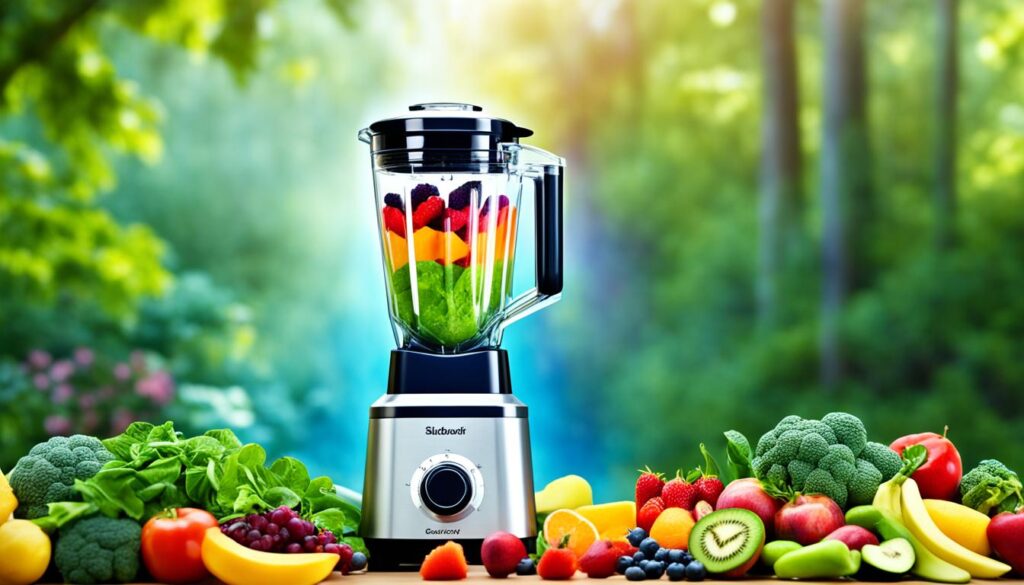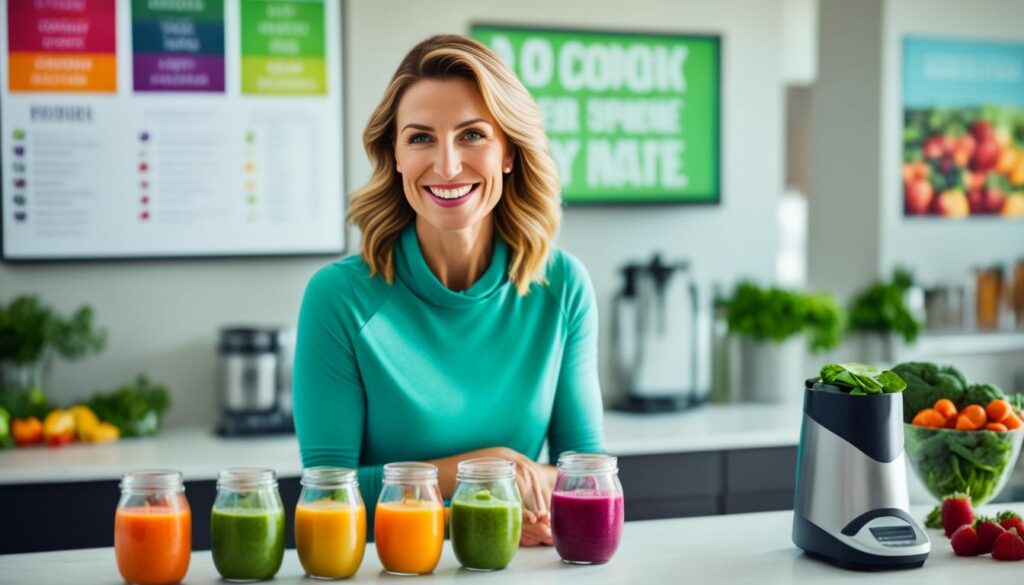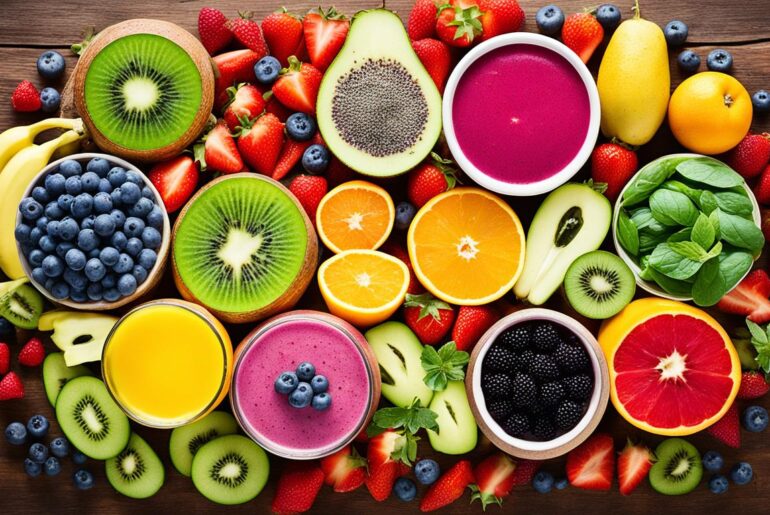Many people eat for reasons other than hunger. They reach for food when sad, stressed, or scared. This can make losing weight hard. It’s important to know why we eat like this. To break the cycle, we can check our feelings, do something else besides eating, and get help from others.
The Smoothie Diet is a great way to deal with this habit. It uses tasty, healthy smoothies to change how we eat. These smoothies are full of good nutrients. They offer a better option than usual comfort foods. This helps a lot with losing weight and getting healthier.
Key Takeaways
- Emotional eating is a common response to negative emotions.
- Recognizing triggers like stress or boredom is crucial.
- The Smoothie Diet offers a healthy way to transform eating habits.
- Emotional checks and non-food-related activities can manage triggers.
- Seeking support can greatly aid in overcoming emotional eating.
Understanding Emotional Eating
Emotional eating happens when we eat not because we’re hungry, but because of our feelings. Stress or boredom can make us crave foods that are tasty but not good for us. These foods are often high in calories and low in nutrients.
What is Emotional Eating?
Emotional eating is when we eat due to feelings, not hunger. Food becomes more than just food; it brings comfort or joy. Sadly, it can lead to eating more than we need. This may cause bad health and poor ways of dealing with feelings.
To fight emotional eating, we need to understand it first. There are four stages: trigger, cover up, false bliss, and hangover. Knowing these stages can help us eat better and feel better too.
Common Emotional Eating Triggers
Many things can make us eat for emotional reasons. We crave certain foods not because we’re hungry, but to feel better. Common reasons include:
- Stress: This can make us reach for sugary and fatty foods.
- Boredom: Leads to eating without thinking, even if we’re not hungry.
- Loneliness or Anxiety: Food can seem like a friend when we feel sad or alone.
Understanding these triggers is the first step in managing them. A journal of our food and feelings can help. Eating mindfully helps us recognize real hunger from emotional hunger. This way, we can have a healthier relationship with food.
The Impact of Emotional Eating on Health
People often eat for reasons other than being hungry. This can offer comfort but isn’t great for health. It’s important to know the difference between eating because you’re hungry and eating because you’re feeling something else.
Physical Health Effects
Emotional eating can harm your body. It usually means eating too much junk food. This can lead to weight gain and diseases like diabetes and heart problems.
When eating becomes a habit, you might eat too much without realizing it. This can make health problems worse by not paying attention to true hunger signals.
Mental Health Implications
Emotional eating also affects your mind. It creates a cycle: eat when upset, then feel guilty. This guilt can make using food as a coping tool even more common.
Most people will emotionally eat at some point. But, focusing on mindful eating can drop its occurrence significantly. Being aware helps manage emotional eating better.
How The Smoothie Diet Can Help Reduce Emotional Eating Triggers
Emotional eating can be a big problem in living a healthy life. The Mayo Clinic says major events or small hassles cause negative feelings. These lead to emotional eating. This kind of eating happens suddenly, different from normal hunger that comes on slowly.
The Smoothie Diet helps fight emotional eating triggers. It uses nutrient-rich foods and planned meals. This way, you avoid quick food choices based on feelings. Using The Smoothie Diet makes eating more structured and mindful. It’s key to stop eating out of habit, experts say.

Tracking your smoothies and feelings is a big part of this diet. It shows eating habits and helps you become more mindful. Smoothies can replace unhealthy snacks like ice cream or chips. These snacks may feel good at first but can make you feel guilty later.
The Smoothie Diet has more benefits than just stopping emotional eating. It promotes health by ensuring you get balanced nutrients. It can change how you view food, leading to a better and healthier eating pattern. The diet helps you not use food to deal with stress. This supports your mental well-being and starts good eating habits that last.
Let’s look at how The Smoothie Diet helps with emotional eating triggers:
| Advantages | Psychological Impact | Physical Benefits |
|---|---|---|
| Structured Meal Planning | Decreases impulsive eating behaviors | Promotes nutrient balance and satiety |
| Nutrient-Rich Ingredients | Enhances mood and reduces cravings | Improves overall nutrition and energy levels |
| Mindful Eating Practices | Increases awareness of emotional triggers | Supports weight management and digestion |
In summary, The Smoothie Diet is great for beating emotional eating. It encourages meals that are planned and full of nutrients. This creates a healthier, more mindful way of eating. The result is better health for both your body and mind.
Benefits of The Smoothie Diet for Emotional Eating
The Smoothie Diet can really help with emotional eating. It offers the right nutrition to help control cravings and keep your body healthy.
Smoothies are full of fiber which makes you feel full for a longer time. This cuts down on wanting snacks that are high in sugar, carbs, and fat. It helps stop emotional eating by reducing the need for unplanned snacks.
The great thing about smoothies is they taste good and can make you happy. A nice smoothie can make you feel good and forget about emotional eating. There are so many flavors, from greens to berries, that give you the nutrients you need.
Adding smoothies to your diet gives you better mood and less cravings. This helps your overall health and fights emotional eating habits. It does this by swapping bad snacks with good, nutritious ones.
Here are the main ways The Smoothie Diet helps with emotional eating:
| Key Benefits | Details |
|---|---|
| Balanced Nutrition | Helps maintain overall health and reduce cravings. |
| Increased Satiety | Fiber-rich ingredients keep you fuller longer, cutting down on impulsive eating. |
| Reduced Temptation | Minimizes the urge for high-calorie comfort foods. |
| Enhanced Mood | Variety and tastiness of smoothies can uplift your spirits and reduce emotional cravings. |
Smoothies are a fun, tasty way to handle emotional eating. They make sure you get the nutrients you need while helping you manage emotional triggers.
Identifying Your Emotional Eating Triggers
It’s key to know why you turn to food when upset or stressed. Emotional eating might happen when we’re stressed, sad, or bored. This habit uses food to cope with feelings.

Recognizing Emotional Patterns
First, notice when you eat for emotional reasons. You might pick certain foods to feel better. It’s important to know the difference between being really hungry and just eating because you’re upset.
Emotional hunger can make you crave certain foods. You might feel bad after eating them. Learning this can help you stop.
Keeping a Food and Emotions Journal
A food and feelings diary could help you a lot. Write down what you eat and how you feel then. This way, you can see what triggers your emotional eating.
You may eat more when stressed or lonely. Knowing your triggers helps you handle feelings better. This can lead to less emotional eating.
Mindful Awareness and Its Role in Reducing Emotional Eating
Learning to be mindful helps fight emotional eating. It makes us pause and think about our hunger. This way, we can tell if we’re really hungry or just emotional. Stress often makes this hard to see.
Practicing Mindfulness Before Eating
Being mindful before meals is a great strategy. Just take a deep breath and listen to your body. This helps us eat because we’re hungry, not just upset or stressed.
Using Mindfulness to Distinguish Between Physical and Emotional Hunger
It’s important to know the difference between being hungry and just wanting to eat. Physical hunger is about your body needing food. You may feel your stomach growl. Emotional hunger is wanting to eat for comfort. It’s more about craving certain foods.
By being mindful, we notice these signs better. We learn to deal with our feelings without eating. This helps stop feelings of guilt and builds a healthier food relationship.
Healthy Smoothie Recipes to Combat Emotional Eating
Finding great healthy smoothie recipes can help with emotional eating. They are full of good stuff. These smoothies help with cravings and make you feel better. Here are two tasty smoothies for a healthier lifestyle.

Green Detox Smoothie
The Green Detox Smoothie is full of good things to clean your body. It has spinach and kale, which help your gut. Pineapple has bromelain, which fights inflammation. Add a tablespoon of plant-based protein for more protein.
Here’s a quick recipe:
- 1 cup spinach
- 1 cup kale
- 1/2 cup pineapple (including the core)
- 1 tablespoon plant-based protein powder
- 1 cup water or coconut water
- Ice cubes (optional)
Mix everything until smooth. Enjoy this drink to feel good and eat less when stressed.
Berry Bliss Smoothie
The Berry Bliss Smoothie is full of antioxidants. Berries give sweet tastes and make you feel happy. Adding yogurt with probiotics is good for your gut and digestion.
Here’s how to make it:
- 1/2 cup strawberries
- 1/2 cup blueberries
- 1/2 cup raspberries
- 1/2 cup yogurt (dairy or plant-based)
- 1 apple, chopped (for additional fiber)
- 1 cup almond milk or any plant-based milk
- 1/2 cup ice cubes (optional)
Blend everything until it’s smooth. Have this tasty smoothie to deal with emotional eating. It’s also great for a sweet craving.
Adding these smoothies to your day helps with losing weight. They can make handling emotional eating easier.
Creating a Supportive Environment for The Smoothie Diet
Starting The Smoothie Diet for reducing emotional eating triggers means making a supportive space. This involves getting support from those close to you for motivation and responsibility. Also, being part of a group with similar goals can provide helpful tips and friendship.
One important step is to clear out unhealthy snacks at home. Keep lots of fruits, veggies, and ingredients for smoothies around. This makes it easy to choose healthy snacks instead of unhealthy ones when you’re feeling emotional.

A study with 48 healthy adults looked at different drink amounts, from 250 mL to 569 kJ. They used a special design for the test order and split participants into two time groups. The findings indicated that people compensated less for calories at 2 hours than at 2 minutes, showing that liquids are consumed quicker than solids.
This research, okayed by the University of Bristol, showed that structure affects eating habits. People followed a set eating plan and received £50 after the last session. They tried different preloads like water, blackcurrant squash, milk, smoothies, and real fruit.
Also, being ready emotionally is crucial for success. Since emotional eating is often a response to stress, handling these feelings properly is key. Swapping high-calorie snacks for nutritious smoothies helps lessen the urge to eat due to emotions.
- Seek support from family and friends
- Join a supportive community
- Remove unhealthy temptations
- Stock up on healthy ingredients
To sum up, a good environment is vital for The Smoothie Diet for reducing emotional eating triggers. With both social and emotional support, plus keeping healthy food on hand, following healthier eating habits is more doable.
Emotional Self-Care Strategies
Many of us eat when we feel stressed, sad, or upset. Yet, this only helps for a little while. Turning to food too often for comfort can make us feel guilty. It’s better to try emotional self-care strategies instead. This is a good way to deal with tough feelings.
Alternative Activities to Emotional Eating
There are many other things we can do instead of eating when we’re emotional. Here are a few tips:
- Exercise: Moving around by taking a quick walk, doing yoga, or dancing makes us feel happier.
- Hobbies: Focusing on things we enjoy, like painting or reading, keeps our mind busy and happy.
- Relaxation Techniques: Trying deep breaths or meditation can help us chill and feel less stressed.
Building a Routine for Emotional Well-being
Having a daily plan that includes emotional self-care strategies boosts how we feel. Sticking to a routine can control our feelings and stop us from eating for comfort. Here’s what you can do:

- Morning Yoga: Yoga in the morning makes the day start smoothly and lowers stress.
- Gratitude Journal: Writing about the good things in life shifts our attention from bad to good feelings.
- Evening Meditation: Meditating before bed helps us unwind and get a good night’s sleep.
Mixing these emotional self-care strategies into our daily lives can help fight the urge to eat when we’re not hungry. This way, we can get along better with our feelings and what we eat.
| Emotional Situations | Alternative Activities |
|---|---|
| Frustration | Squeezing a stress ball |
| Sadness | Listening to uplifting music |
| Overwhelm | Deep breathing exercises |
| Anger | Beating a rug against a wall |
| Disappointment | Writing in a gratitude journal |
| Fear | Calling a friend to vent |
Reevaluating Your Relationship with Food
Reevaluating your relationship with food helps you to eat healthier. It’s about changing how we see food. We move from eating just for comfort to eating for health.

Shifting from Comfort Food to Nourishing Food
A key step is swapping comfort food for healthier options. Often, we eat because we’re stressed or bored. Recognizing why can help us make better choices.
- Mindful awareness: Emphasize being present and conscious about your eating habits.
- Supportive environment: Surround yourself with friends, family, and professionals who can aid in overcoming emotional eating habits.
It’s important to see food as something that helps us, not just comforts us. Think of food as a supportive friend.
Finding Joy in Healthy Eating
To really change how you see food, find joy in healthy eating. Try new flavors and practice mindful eating. Appreciate the good in nutrient-rich foods.
- Alternative self-care methods: Replace emotional eating with activities such as taking a walk, journaling, or practicing meditation.
- Professional support: Seek guidance from a registered dietitian, therapist, or counselor if needed to develop a healthier relationship with food.
As we get older, we might not feel hungry like we used to. By paying attention and eating mindfully, we can manage better. Give yourself permission to enjoy food and focus on the experience.
Setting Realistic Goals on The Smoothie Diet
It’s key to set achievable goals when starting a smoothie diet. Begin with goals that are easy to reach. They should be clear and have a deadline. This way, you slowly make progress without feeling stressed. Try to switch one meal a day with a filling smoothie. Choose ingredients rich in fiber to keep you full and cut down on calories.
Losing 1 to 2 pounds each week is a good goal. It helps with keeping weight off for good. You’ll eat fewer calories but still get to enjoy many different foods. Fruits, veggies, and proteins make your meals colorful and tasty.
Here are some effective goals to consider:
- Introduce smoothies with fruits, veggies, protein, and healthy fats for fullness and weight help.
- Use portion control to keep an eye on your calorie intake.
- Add more variety to your ingredients to keep things interesting and nutritious.
- Start by replacing one meal a day with a smoothie to make the change easier.
This table shows how a smoothie compares to a regular meal in fiber, calories, and weight loss:
| Aspect | Smoothie | Conventional Meal |
|---|---|---|
| Fibre Content | High due to fruits, veggies, seeds | Varies, often lower in fiber |
| Caloric Levels | Low, nutrient-rich | Can be high-calorie |
| Weight Loss Benefits | Supports gradual, sustainable loss | Depends on meal composition |
Setting goals with your own lifestyle in mind is vital. Think about your age, sex, and how active you are. A plan made just for you keeps you going and avoids feeling let down. Committing to a planned smoothie diet builds habits for lasting results.
Seeking Professional Support
Sometimes, emotional eating is complex and requires professional help. This is key if it leads to health problems like weight gain, diabetes, or heart issues. Knowing when to get help is crucial.
When to Consider Therapy
Therapy is useful for emotional eating issues. Emotional hunger is often mental, not physical. Feelings like guilt and shame can make eating habits worse. A therapist can help with negative feelings and teach good coping skills.
Finding a Dietitian or Nutritionist
Working with a dietitian or nutritionist is another way to get support. They can guide you on how to balance The Smoothie Diet in your life. They tell physical hunger from emotional hunger.
They can make a plan for eating healthy. This keeps you from eating for comfort. Knowing it’s not all about willpower is key for lasting changes.
Getting professional support can greatly help your food and emotional health.
Integrating The Smoothie Diet into Your Daily Routine
Starting The Smoothie Diet needs some planning and sticking to it. Getting ready ahead of time makes a big difference. When you prepare smoothie parts ahead, it’s easy to make healthy meals. Set days and times for smoothies to improve your eating habits and digestion.
The smoothie diet benefits include lots of fiber and protein. These keep you full and cut down on calories. By sticking to a smoothie schedule, you build healthy habits that overcome unhealthy eating.
The Smoothie Diet lasts 21 days and has 36 recipes. You replace two meals a day with smoothies, focusing on key nutrients. The ingredients are low calorie but very filling and good for you.
Using a digital book with over 35 smoothie recipes helps a lot. It keeps you organized with all the ingredients you need. Regularly making smoothies helps control calories and can lead to weight loss by encouraging better habits.
Here’s a table with benefits and tips for The Smoothie Diet:
| Strategy | Benefits | Tips |
|---|---|---|
| Batch Preparing Ingredients | Streamlines Process, Readily Available Meals | Prepare components in bulk during weekends |
| Setting Meal Times | Consistency in Eating Patterns, Improved Digestion | Stick to a regular smoothie schedule |
| High-Fiber and Protein-Rich Smoothies | Fullness, Satisfaction, Reduced Calorie Intake | Incorporate vegetables, fruits, and protein sources |
| Using Digital Recipe Books | Organized Meal Planning | Follow guided recipes and shopping lists |
| Replacing Meals | Supports Weight Loss, Nutrient-Dense Intake | Substitute 2 meals with the recommended smoothies |
By adding these smoothie diet benefits to your daily routine, you’re on the way to better health and eating habits.
The Smoothie Diet for Reducing Emotional Eating Triggers
Emotional eating happens when we eat not because we’re hungry, but because we feel stressed or lonely. It can cause weight gain and unhealthy eating habits. The Smoothie Diet is made to help people control these triggers through tasty, healthy meal plans.
The diet focuses on foods full of nutrients. This helps build better eating habits and reduces the need to eat for comfort. Emotional hunger starts in the mind, making us think about food all day. This is different from being really hungry, which makes our stomachs growl.
Some people think they just lack willpower. But it’s more about not knowing the emotional reasons behind their eating. The Smoothie Diet helps by focusing on these emotional triggers, like:
- Trigger: Noting which feelings make you want to eat.
- Cover Up: Eating to hide those feelings.
- False Bliss: Feeling good for a little while from eating.
- Hangover: Feeling guilty after eating too much.
This cycle of eating because of guilt and shame can keep going. It’s important to learn new, healthy habits to stop this cycle. Talking with a coach or therapist can help find out why you eat for emotional reasons.
Knowing the difference between eating because you’re hungry or emotional is key. The Smoothie Diet gives a plan that helps make better choices. This helps you think more about why you’re eating and stop eating too much because of your feelings.
Let’s look at different types of eating and what they mean:
| Eating Type | Description |
|---|---|
| Emotional Eating | Eating for non-hunger reasons, often due to stress or boredom. |
| Physical Hunger | Starts with stomach signals like growling when you’re truly hungry. |
| Overeating | Eating more food than your body needs. |
| Compulsive Eating | Eating mindlessly without really thinking about it. |
| Binge Eating | Eating a lot of food quickly, usually because of emotional upset. |
By using The Smoothie Diet, people can learn how to have a healthier relationship with food. With smoothies and planned meals, fighting against emotional eating gets easier.
Conclusion
The Smoothie Diet offers a new way to beat emotional eating. It teaches healthy eating habits and mindfulness. With nutritious smoothies, it cuts the need for sugary snacks. This helps when stress makes us reach for food.
It’s important to know why we feel hungry. Is it emotion or true hunger? Emotional hunger can lead to eating too much. This might be because we’re bored or lonely. Keeping a food diary helps spot what triggers this hunger. If this issue stays, seeing a therapist or counselor is a good idea.
To have a good relationship with food, being aware is key. Know when you’re truly hungry or full. There will be times we slip up, but we must keep trying. The Smoothie Diet supports this journey. It aims to help with weight loss and emotional health through tasty smoothies.




